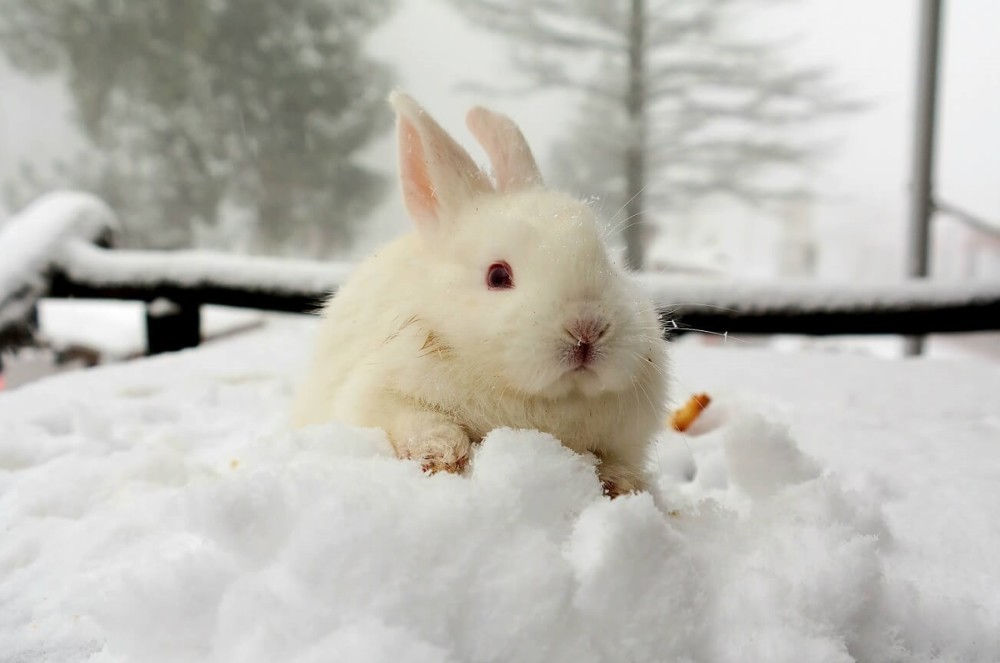Raising rabbits in the cold can seem intimidating but nearly half the world, and definitely, half the United States lives in colder climates at least part of the year. It may surprise you to learn that rabbits adjust much better to cold weather than they do to hot weather. But, there are still several things that you should do to keep your rabbits safe in very cold weather.
How To Keep Rabbits Warm In Sub-Freezing Weather
- Allow rabbits to adjust to cold temperatures
- Provide a wind-free shelter
- Keep rabbits dry
- Provide plenty of hay and food
- Access to water
- Winter exercise is important
In addition, we’ll cover having litter during the winter and other tools you can use to keep your bunnies warm.
1. Allow Rabbits To Adjust To Cold Temperatures
Rabbits are one of the toughest animals in the winter. Wild rabbits extend into the far north and are able to survive and thrive in cold temperatures. Understanding how wild rabbits survive without human protection is essential to understanding how your rabbits can survive in very cold temperatures.
Wild rabbits are outside all year round. This means that during the fall months, when the days are both warm and cool, their fur starts to thicken and their bodies prepare for a cold winter.
That means,
Although it might be tempting to bring your rabbits inside during colder fall nights, you must leave them outside. Rabbits need time to adjust to the colder weather and fall provides that time.
It is very dangerous to your rabbits to have them inside while the weather cools and them to suddenly decide that you need to keep them outside and the temperatures have already fallen. This will usually shock their bodies and can do a lot of damage to their health.
Rabbits are much more likely to suffer from hypothermia and other cold-related health issues when they have been kept warm and suddenly placed outside in cold weather.
If your weather is like mine, you might see super cold spells during the fall, followed by warm, summer-like spells. Don’t worry about those short cold spells, even when the temperature drops suddenly. That’s a great warning signal for your rabbits, who will respond by growing thicker fur.
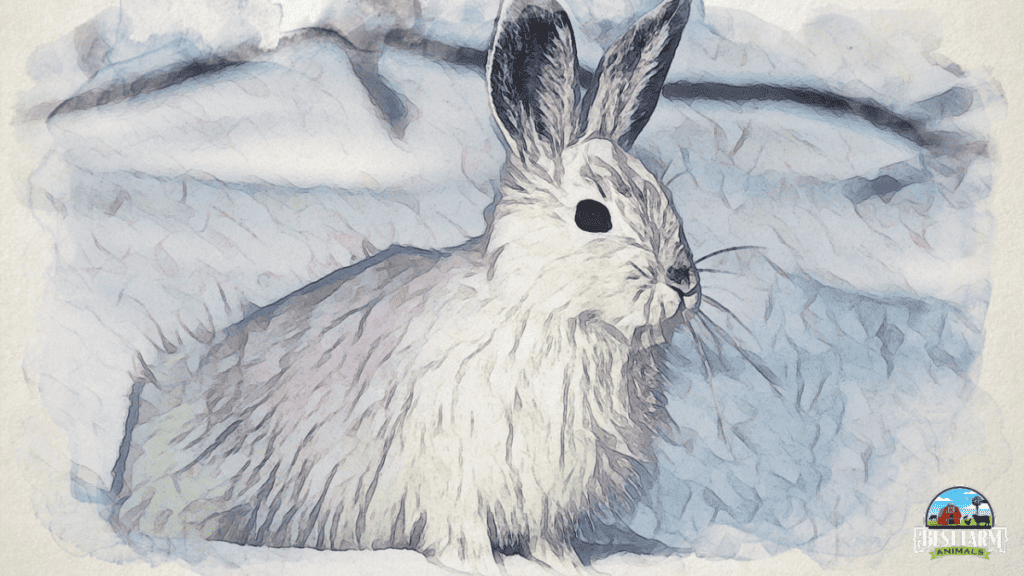
How do I know if my rabbit is warm enough?
One of the first signs that your rabbit is warm enough is when they flop onto the ground and lie with their paws outstretched. If your rabbit is in the “loaf” position (limbs tucked tightly under their body), this show’s that they feel cold. Check the temperature of your rabbit’s ears. If the ears are warm (not hot), then the rabbit is warm enough.
Did you know?
Rabbit fur is one of the warmest and thickest winter protection available! And your rabbits get it naturally!
Can rabbits stay warm in the winter?
A rabbit can stay warm by shedding their summer coat and growing a heavier coat in winter. They also sleep in the “loaf” position by tucking their limbs closely under their body, creating extra warmth and less surface area that touches the cold. Rabbits will eat more to make an insulating layer of fat on their bodies to help them stay warm.
2. Provide Rabbits With A Wind-Free Shelter
Whether you raise rabbits in cages or in hutches, your rabbits need shelter from the wind. The wind drastically reduces body heat. While temperatures maybe 10 degrees Fahrenheit, the wind chill maybe 2 degrees Fahrenheit or even lower.
Rabbits have a hard time competing with a cold wind that sucks the warmth away from their bodies.
In the wild, rabbits burrow into the snow and ground to gain protection from the wind. Rabbits often use the same burrows in the winter that they dug in the summer. Because they are underground, the burrows seldom freeze and provide a more moderate temperature for rabbits.
Rabbits in cages don’t need to be warmed artificially, but they do need a wind block. This can be done with a permanent structure or a temporary one.
If you use a hutch to protect your rabbits from the elements, make sure the hutch is larger than the cage. Rabbits can and will chew the wood of the hutch if they can reach it.
Use plywood panels, tarps, or sheds to block the wind. Rabbits cages shouldn’t be airtight. They need to have an adequate circulation of air, but they should be protected from cold winter winds.
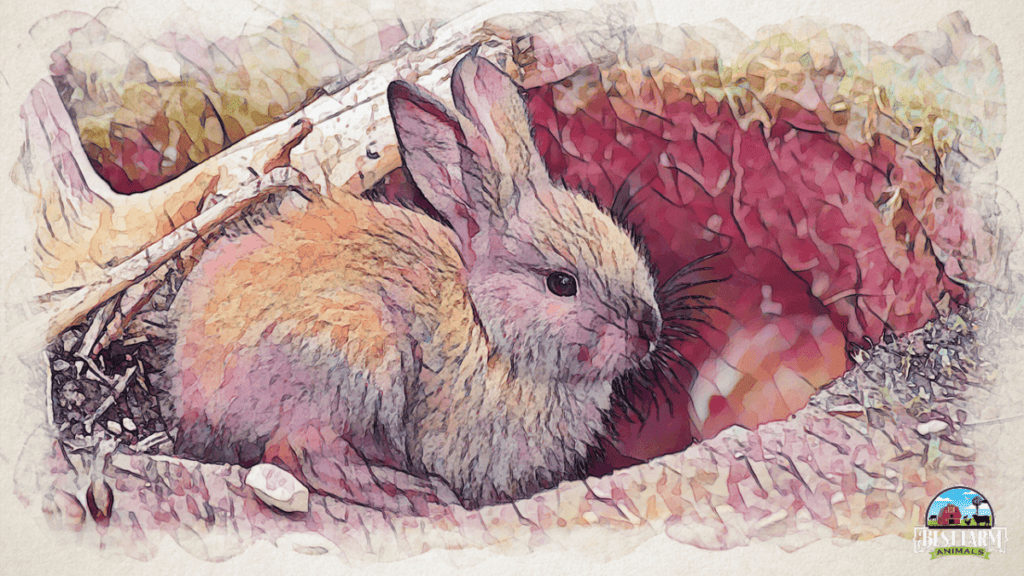
There are several ways to protect your rabbit cages:
Place rabbit cages inside a shed, barn, or unused garage
The existing structure can shield rabbits from the wind. Make sure to not use a garage that you use as even very little amounts of the exhaust can kill your rabbits. They are smaller and will respond much quicker to carbon dioxide.
If your shed or barn doesn’t have doors, has an open side to the elements, or is very drafty, you will need to take additional steps to further protect your rabbits from the wind.
How do you heat a rabbit cage?
There are several safe ways that you can heat a rabbit cage, such as providing extra bedding like hay or shredded newspaper for insulation. Consider purchasing a heat lamp designed for small animals (keep it out of the rabbit’s reach and away from their bedding). You can also move the cage to a warmer area in your home.
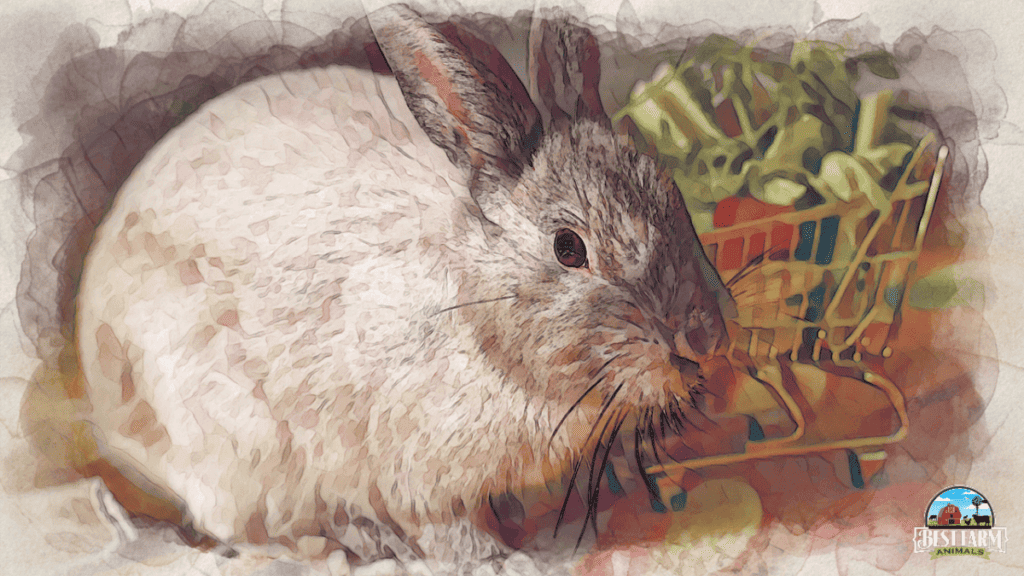
Use tarps, plywood, or other items to shield hutches from the wind
Another way you can protect your rabbits is with a simple tarp or plywood shield. Simply wrap the tarp around your rabbit homes. Be careful to allow a couple of inches of open space at the top and bottom of the cages to allow for air circulation.
Don’t leave the gaps on the sides of the cages where your wind comes from. In my area, the wind comes from the East in the morning and the North in the afternoon. As a result, the East and North sides of my rabbit cages need to be completely protected from the wind. I can allow space for air circulation on the other two sides. A couple of inches does the trick.
If you can’t avoid the wind because it comes from all directions, place plywood a few inches out of the cages or hutches to block the wind. This will allow the air to circulate, while still providing protection.
Another method is to cover the cages with tarps, but angle the tarp down away from the cage. This will serve to drain water away from the cage and also to provide a wind block.
Winterize rabbit cages and hutches
A third option is permanently protecting your rabbits by winterizing their cages or hutches. This option is a little more expensive but requires less time during winter.
Add permanent or removable walls to your cages or hutches that can be added during the winter. Paint the wood, or add water-proof siding or metal sheeting to protect the hutches from the moisture and block the wind.
If you paint the hutches, they will need to be repainted every few years to maintain their weather protection.
How do I keep my rabbit hutch warm in the winter?
There are several safe ways to keep a rabbit hutch warm in winter. Start by raising the hutch off the ground to avoid frost formation on the hutch. Provide your rabbit with extra bedding, such as hay and shredded newspaper, and also ensure your hutch is weatherproof by blocking any cracks or gaps where a draft can pass through.
What is the best way to insulate a rabbit hutch?
The best way to insulate a rabbit hutch is by lining the walls of the hutch with cardboard and lining the floor with newspaper. This will insulate the hutch and keep the rabbit warm. For extra insulation, you can place an old blanket or carpet on the hutch’s roof and cover the entire hutch with a weatherproof tarp (but still allow air in).
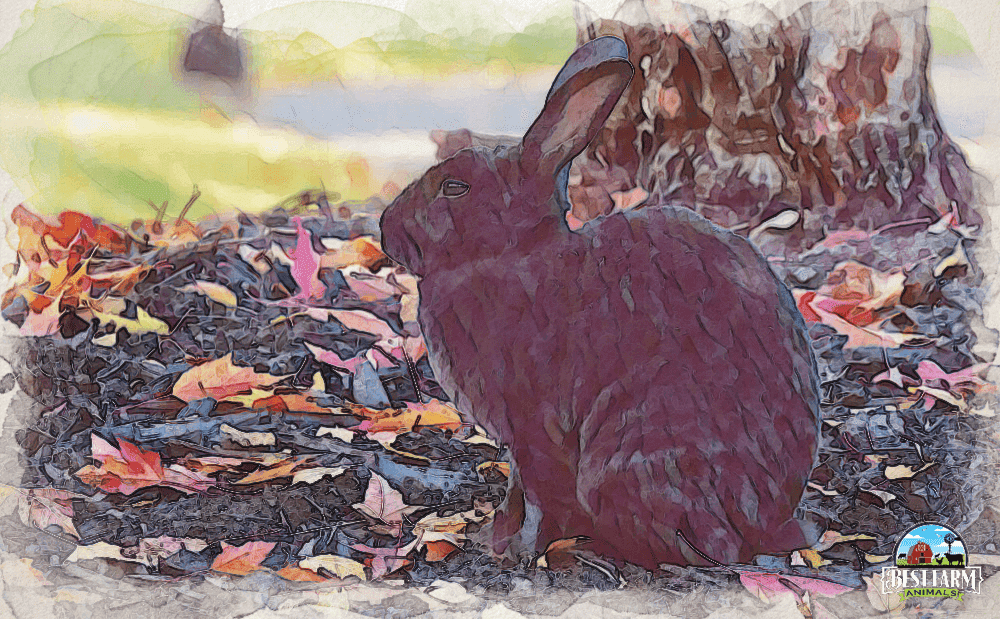
Allow air circulation even while blocking the wind
Rabbits need fresh air. The ammonia from their urine can build up and cause issues when they inhale it. A couple of inches of open space allowed new air to come in.
Air circulation also helps to prevent any mold issues and respiratory problems with your rabbits.
Remember,
Cold air isn’t dangerous, but wet, cold, moldy, or ammonia-filled air can be dangerous.
Bay hales can provide shelter
Another option is to use hay or straw hales to provide wind protection. Place around your rabbit cages. They are easy to stack and if you purchase them directly from local farmers, they are usually only a few dollars. They are as much as $10-15 at animal supply stores.
Straw goes for even less and can often be found listed for free on classified ads, but remember that your rabbits can’t eat straw and it isn’t useful for them unless you are using it as a wind and rain block.
3. Keep Rabbits Dry
Wet rabbits absolutely cannot maintain their body heat. Rabbits must be able to stay dry. In the wild, rabbits hunker down into the ground during winter storms, but caged rabbits aren’t able to do that.
In addition to using tarps and other shields that will block the wind and help protect rabbits from the rain, ensure that the tops of your hutches and cages are waterproof.
Add corrugated sheets, paint, or use roofing tar to waterproof your hutch roofs. You can also drape a tarp or plastic over the cages.
It doesn’t matter as much what materials you use, but it does matter that you provide a place where your rabbits can have a dry place to sleep and eat.

Raise rabbits above ground level
Unless your rabbits are living colony style in an area where they can burrow down, rabbit cages should be lifted above ground level.
There are several reasons for this.
First, cold airdrops. Even outside where you might assume that all the air is the same level of chilliness, it is often a couple degrees colder close to the ground.
Additionally, the dew, moisture, and humidity tends to be denser near the ground. In the fall, the dew will chill rabbits. In the winter, the extra moisture can be deadly.
Raise hutches and cages up by placing them on bricks, adding permanent legs, or placing them on an old table or on shelves.
But, make sure your rabbits are at least 2 feet above ground level. If you live in an area where the snow piles several feet high, you will need to raise cages even higher.
Avoid placing cages in areas where the snow will drift and gather.
Predator Protection
Raising your cages and hutches above the ground also provides predator protection for your rabbits. Raccoons are especially dangerous for rabbits as they pull rabbit parts through a cage from the bottom or through the wires.
Rabbits can be harmed or killed this way. If you have cages, be sure to place a litter tray under the cage or line it with cardboard to protect bunnies from raccoon attacks from the bottom of the cage.

4. Provide Plenty of Hay and Food
Hay serves two purposes for rabbits. It provides nesting material and it is the main food source for rabbits.
Did you know?
Straw and hay are different even though they look the same. Hay is full of nutrients and is calorie-rich. Hay usually comprises timothy grass, clover, orchard grass or other grasses. Don’t provide alfalfa hay to your rabbits as it’s bad for adult rabbits. Timothy hay is best.
Straw is a waste product that comes from grains. It has no nutritional value and is empty of calories.
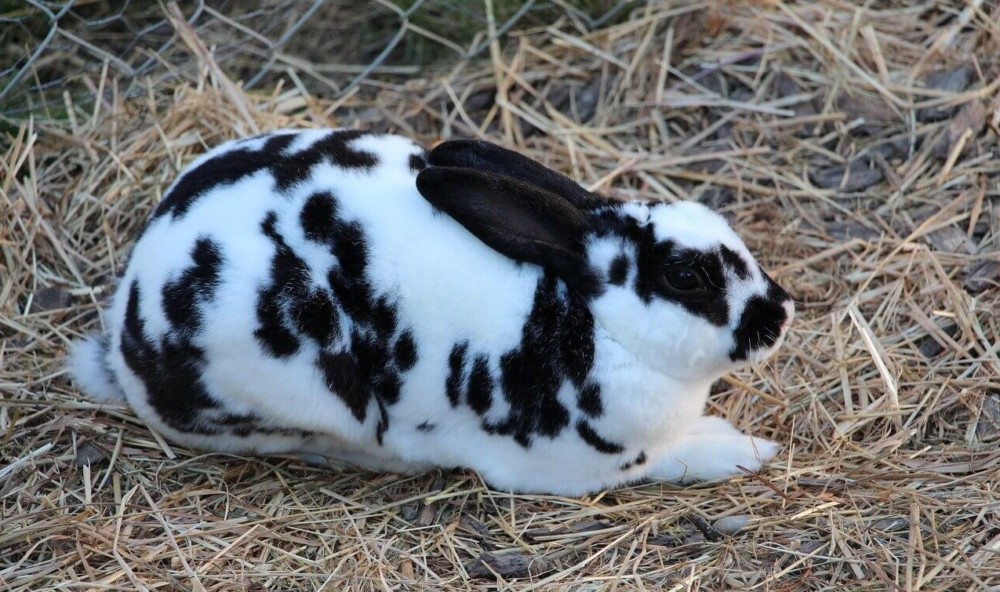
Hay provides nesting material that mimics burrows
One of the two ways rabbits stay warm is by burning extra calories and burrowing. Hay provides for both of these needs.
Make sure to provide a consistent source of hay for your rabbits. Although some rabbit breeders say this isn’t necessary, it does help your rabbits to stay warm. Rabbits mamas will build nests that mimic burrows used in the wild. It helps to add warm protection for rabbits to nest down and sleep.
If you are breeding rabbits in the winter, the mamas will use the hay and pulled fur to keep the kits warm and healthy.
Hay provides calories to keep rabbits warm
In addition to providing nesting material, hay also provides critical calories for rabbits in the winter. Rabbits will consume more food when it’s cold.
Do you know why?
One of the two ways rabbits stay warm is by burning extra calories and burrowing. Hay provides for both of these needs.
Rabbits will eat the hay they use for their nest. Having a constant source of food helps to ensure that your rabbits can produce the heat they need to stay warm.
A hungry rabbit will chill much faster and is more likely to get sick or freeze to death.
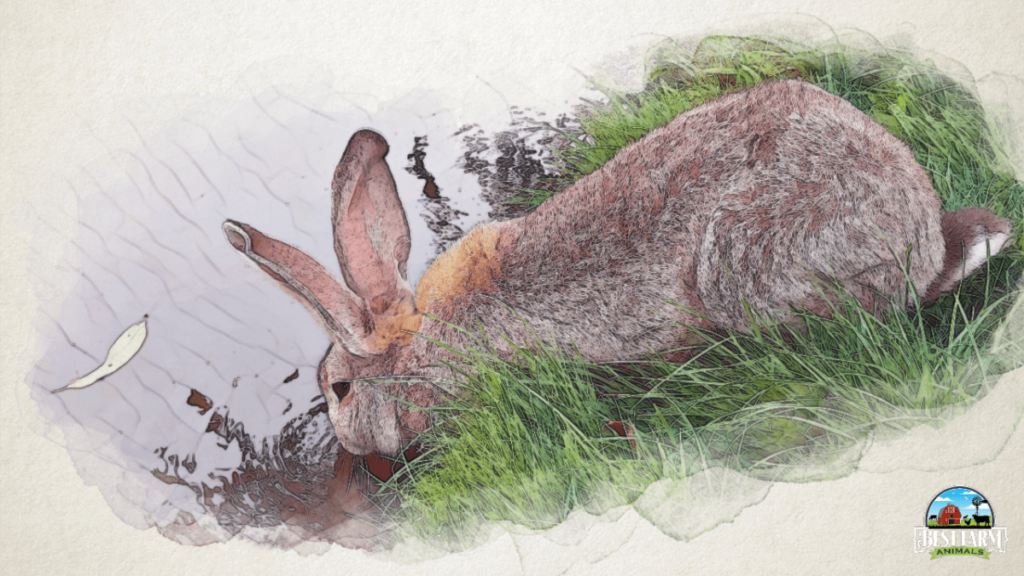
Supplement with 20% protein feed
In addition to providing consistent hay, you can provide a feed supplement with a little more protein than rabbits need in the summer months. The protein provides help for rabbits to stay warm.
This isn’t a necessary step, but if you notice your rabbits struggling to stay warm, additional protein can help to keep them warm.
But,
Don’t resort to using a meat or animal product. Rabbits should never eat animal products and they are herbivores and their digestive system will not handle meat or milk products.
5. Access to Consistent Water
Did you know?
Rabbits will not eat if they don’t have access to water. Even with plenty of food around, a lack of water can cause rabbits to starve. It is critical during cold, winter months to provide adequate water for your rabbits.
There are several methods of doing this effectively. It is possible to provide enough water without electricity for your rabbits to stay warm, but there are also tools that make it easier and keep the water thawed.
Let’s dive into both methods.
How to provide off-grid water for rabbits
During the winter, rabbits need consistent water to stay warm. One of the best ways to do this is to use a water crock. Crocks are thick bowls with high sides. They are made out of rubber, stoneware or ceramic.
They are WAY better than the nipple feeders, which freeze within minutes before rabbits can get enough water for their needs.
They do a lot toward keeping water unfrozen longer. Because the sides are straight, the water is thick the entire width of the crock. That means that unlike a bowl, the water doesn’t start to freeze in the shallow area as soon.
Because they are thicker, they also help to slow the freezing process. Plus, they don’t break or crack as easily.
Plastic, metal, and other thin bowls freeze much faster and break easier.
Crocks are durable enough that you can bang them together and pop the frozen ice out and refill them.
But, don’t fill crocks completely full. Halfway to ¾ full is as full as they should be filled.
Fill crocks with water twice a day to provide enough water for your rabbits. Even though they will freeze, it provides enough water for rabbits to fill up on and stay warm.
After the water freezes, your rabbits will chew on the ice to get additional water, but you shouldn’t rely on them chewing enough ice to stay hydrated and should still provide thawed water twice a day.
Check out crock options here on Amazon.
Tools to provide thawed water for rabbits with less work.
If you are too busy, too cold, or don’t feel like refilling water crocks multiple times a day, there are some solutions that require electricity but will save you time and keep rabbits healthy.
Heated rabbit bottles keep the water and the nipples from thawing. The water only has to be refilled when it runs low.
They are a lifesaver in especially cold days or if you are out of town and have someone else watching your rabbits for you.
Another option is to use a pet water bowl, which will keep the water unthawed, but not warm. It warms the water just enough to keep it from freezing.
Check out this heated rabbit water bottle on Amazon.
You can also check out the heated animal bowls.
6. Winter Exercise for Rabbits is Important
Rabbits need exercise, especially in the winter. It can be hard to give them time to exercise, especially in cages and in the winter. But fat rabbits are more likely to get sick and have other health issues. This can also cause breeding problems during the winter and in the spring.
Take some time to let them out for exercise. Allowing them time outside in the snow, in a shed, or in your garage helps to keep them in shape.
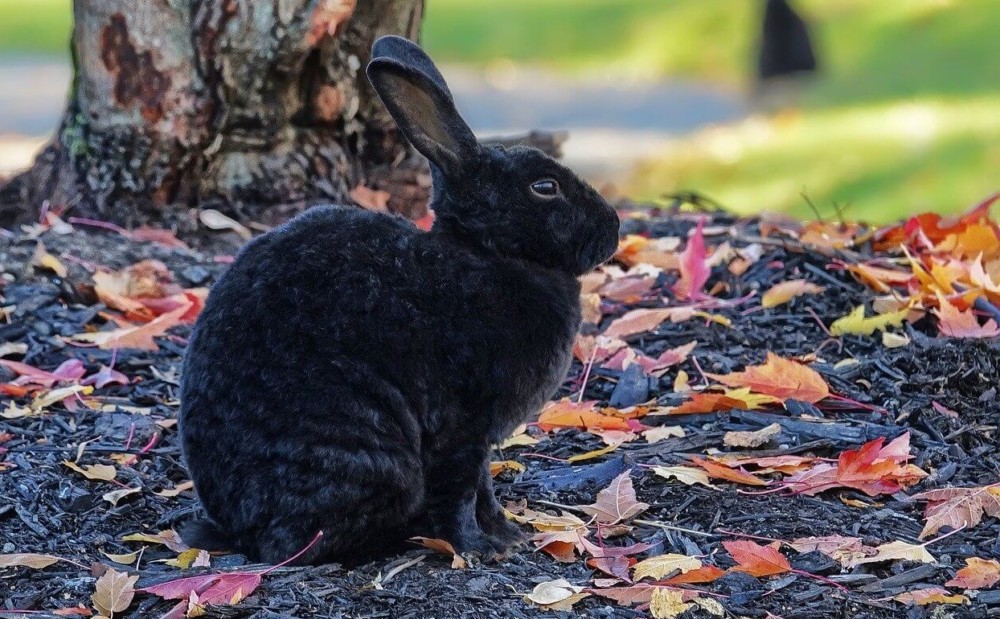
Or, you can provide a protected hutch with a bunny run that’s sheltered so they can spend time running around.
Be careful letting males and females out at the same time to run around unless you plan to breed them. It doesn’t take much time for bunnies to breed.
Raising Kits During the Dead of Winter
Rabbits can have babies and take care of them in very cold temperatures. Kits are usually born with no fur. Mamas pull fur from their underside to line the nest and keep bunnies warm. Providing a box for a nest helps the moms to make a nest.
A simple shoebox works great. Just fill it with hay and your rabbit will make a nest. The fur and hay will keep those babies warm.
The biggest danger for kits is when one gets pulled out of the nest while nursing. This exposes the baby to cold temperatures. You can check on babies frequently and return a stray baby with the rest of the litter.
Can I use a heating pad for baby bunnies?
You can use a heating pad for baby bunnies if you monitor the heat and check on the bunny regularly. You must wrap the heat pad in an old blanket or towel and place it in a shoebox. Ensure the heating pad is on a low heat setting, and place the bunny in the shoebox. This protects the bunny’s skin from making direct contact with the heating pad.
Shelving liters is optional
Shelving rabbit litters refers to bringing little ones to a warmer place the first 3 weeks after they are born. Rabbits nurse only twice a day.
Some breeders like to bring in the litter so the little ones stay warm. Then in the morning and evening, the kits are brought out to the mama for 15-20 minutes to nurse. This provides them with their feeding needs and keeps them warm.
It isn’t necessary to take these steps, but if you do don’t forget a few things:
- If you have multiple litters of bunnies, make sure you label which litter goes to which doe
- Babies can be taken outside after they reach 3 weeks and are able to better maintain body heat themselves
- Babies must be allowed to nurse twice a day
Some rabbits require extra light for reproduction
Rabbits may require a certain amount of light to continue to reproduce. Not all rabbits require this, but if you find that your rabbits stop reproducing during short winter days, you should add lighting.
If your cages or rabbit hutch is sheltered in such a way that blocks the light, you can adjust it to allow more light in. Instead of using a tarp to protect it from the wind, consider a thick plastic or greenhouse plastic wrapped around the cage.
This will protect the rabbits from the wind and water, but also allow in more sunlight.
Or, you can install artificial lighting. There are many lighting sources including solar-powered lights or timed lights. Simply set your lights to come on before dusk and to turn off a few hours later. This extends the “light” hours of the day and will help your bunnies to reproduce.
Solar-powered lights on Amazon
Light timer on Amazon for plugged lights
Heating Options For Rabbits
Heat pads are safe for rabbits if you use them correctly. Ensure you use a heat pad specifically made for small animals, as they contain a non-toxic gel that heats up in the microwave.
Follow the heating instructions to heat the heating pad in the microwave. Once warm, leave it for a minute before wrapping it in a blanket or towel. The heat from the heating pad should last around 5 hours.
Be sure not to leave the heat pad in the rabbit’s cage or hutch without a cover, as rabbits like to chew and might hurt or burn themselves. Place the heating pad in an area where the rabbit doesn’t usually urinate so it doesn’t get damaged.
Are heat lamps OK for rabbits?
Heat lamps are one of the safest options to keep rabbits warm, as the lamp is installed outside the cage. Ensure you use a ceramic heat emitter or use a red light bulb—it dims the light so that the rabbit doesn’t feel stressed. Be careful not to overheat the lamp (keep the temperature below 85 ℉) and at a suitable distance from the cage or hutch.
Are blankets safe for rabbits?
Polar fleece blankets are the safest option for rabbits, as the fibers are much shorter than cotton blanket fibers and won’t cause blockage in their digestive system. While blankets can keep rabbits warm, they do end up being used as a digging area and ripped apart. Rabbits love to dig into blankets and sometimes urinate on them.
If you still feel that some occasions or cold spells require additional resources, then this microwavable pet heating pad, or the 2 pack, can be used to keep your rabbits warm.
I would be super careful about anything that is plugged in and in the rabbit’s cage. Rabbits can and will chew through the wire and that poses a major electrical and fire hazard.
Even the heated water bottle should be hung outside the cage with the plug away from the cage so it is safe.
Frequently Asked Questions
How cold is too cold for rabbits?
Rabbits can do very well in super cold weather if they have the resources to stay warm. Temperatures dropping to -10 degrees below zero (Fahrenheit) can cause frostbite concerns with their ears. Make sure to monitor rabbit ears and ensure that they don’t get wet when drinking water. Even so, most rabbit breeds will still do fine in subfreezing weather.
How can I treat a chilled rabbit?
If your rabbit’s temperature drops dangerously low (under 100 degrees Fahrenheit), it is in critical danger of hypothermia. Make sure the rabbit is dry and wrap a towel around it. Do not warm the rabbit up quickly as that can cause it to go into shock. Apply warm water bottles to help warm the body. Towels should be placed between the water bottles and the body.
You can also bring your rabbit into a warm room and allow her to warm up gradually.
Don’t rub your rabbit to warm it up. This will increase blood flow and is likely to move the colder blood into the center of the body and increase hypothermia.
Are rabbits sensitive to heat?
Rabbits are sensitive to heat and can overheat very quickly. Unfortunately, rabbits cannot sweat to release heat and have to pant and use their ears (large blood vessels there cool the blood) to try and cool down (which uses more energy). This is why rabbits prefer and tolerate cooler temperatures better. If a rabbit overheats, it can be fatal.
Recommended Rabbit Supplies
This list contains affiliate products. Affiliate products do not cost more but helps to support BestFarmAnimals and our goal to provide farm animal owners with accurate and helpful information.
Housing: If your rabbit is indoor, you’ll need a cage, a hideout (to keep your rabbit from death by heart attack), and a space for it to get exercise and spend time with you. If you don’t want to let it run free in your house, this animal playpen provides space and keeps your rabbit from hiding under your couch.
If you keep your rabbit outdoors, an outdoor hutch that provides space and protection from predators is needed. (I’d still keep mine in a barn for further protection from the elements.)
You’ll also need bedding, toys, a grooming brush, and treats for your little friend. A litter box is important because rabbits can be potty trained. Timothy hay is the best kind of hay for rabbits as alfalfa is too sweet. Don’t forget a water drinker. I like the half-gallon waterer because it can cover two rabbits for several days. Pair it with a food bowl or a food manger (a little cleaner) and you’ll be set up!
If you want to treat your bunny to entertainment, a cat tower, a treat ball, or bunny toys all work wonderfully.
Finally, if you plan on taking your rabbit with you on trips, you’ll need a carrier. Here’s a small carrier or larger carrier that work great for occasional travel. If you travel a lot, you might want the carrier that’s rated #1 in safety for safe travels
Lastly, I use this odor eliminator for accidents and to wipe out the bottom of the cage and litter box when I clean it.
Related Articles
What Do Rabbits Eat? What’s Safe, What’s Not: A Full Guide

